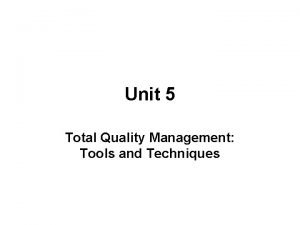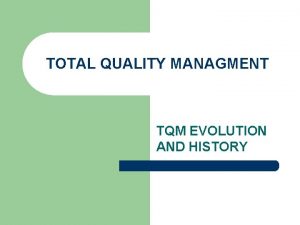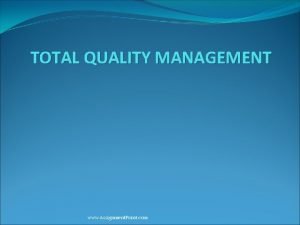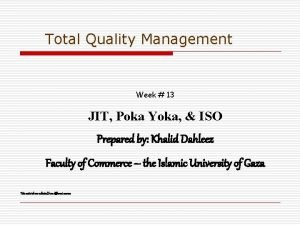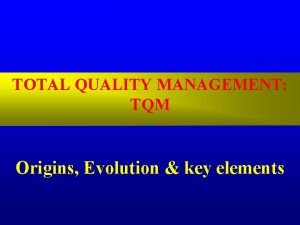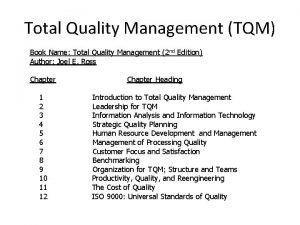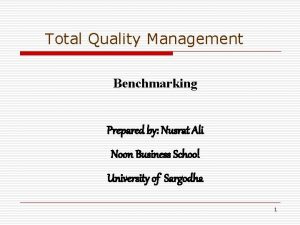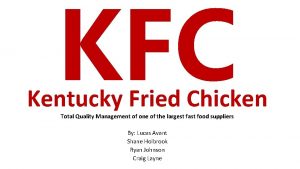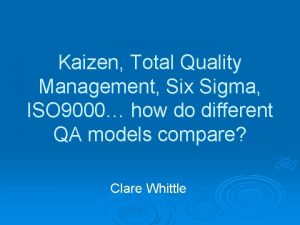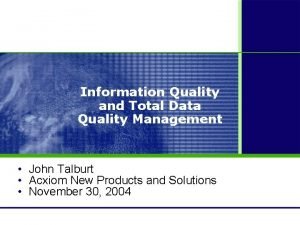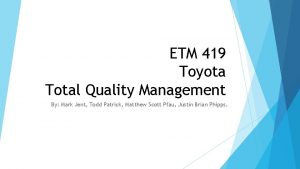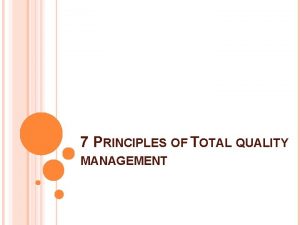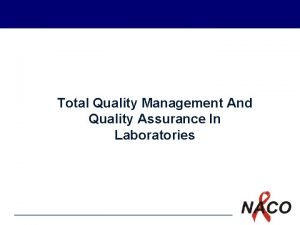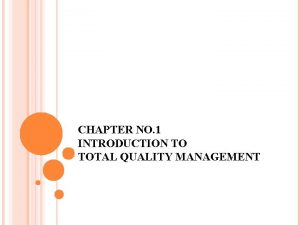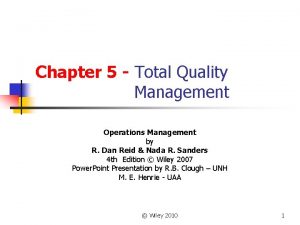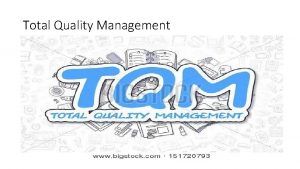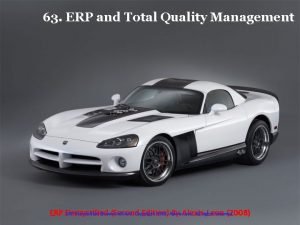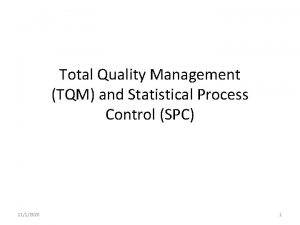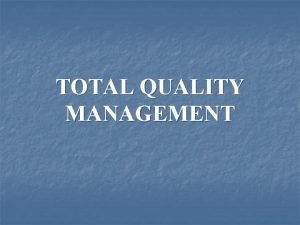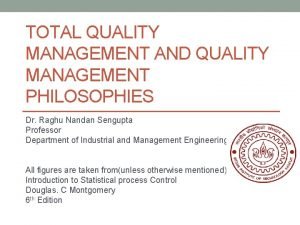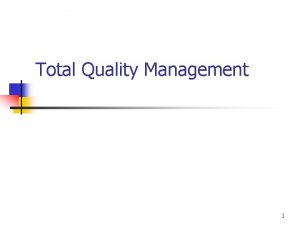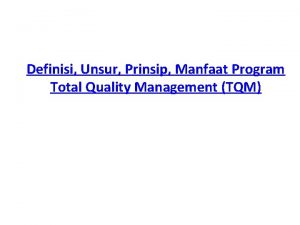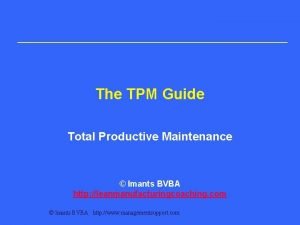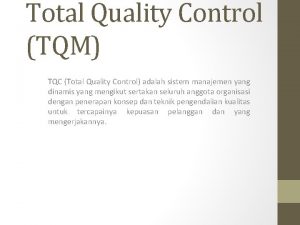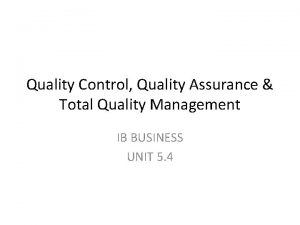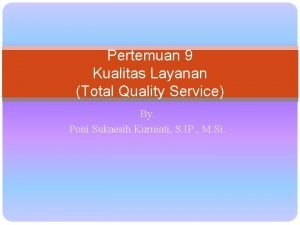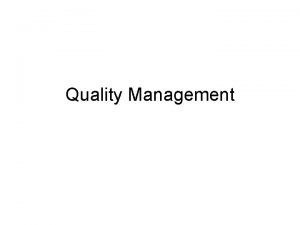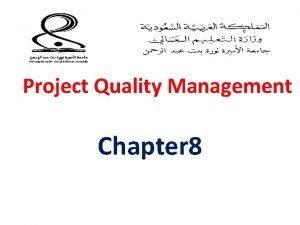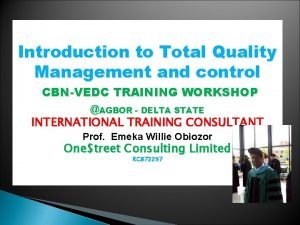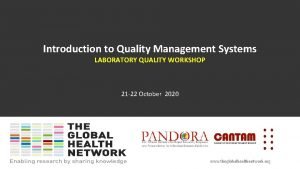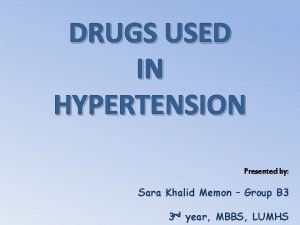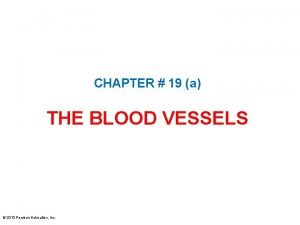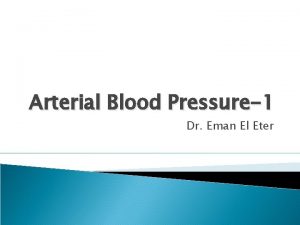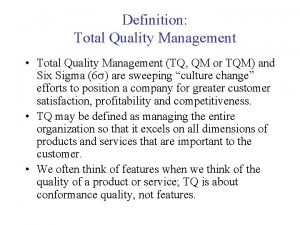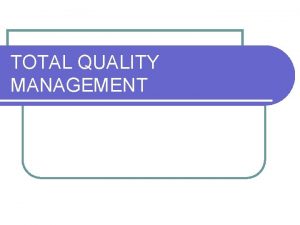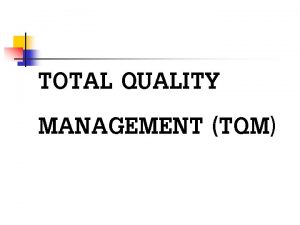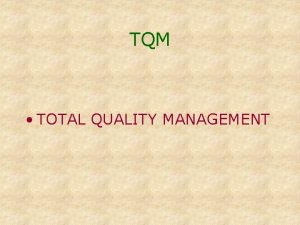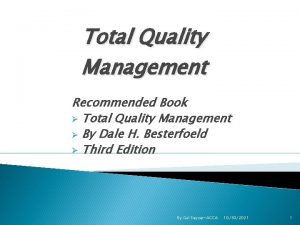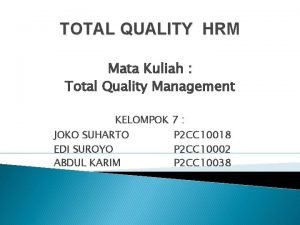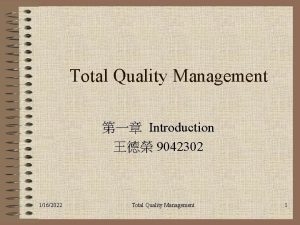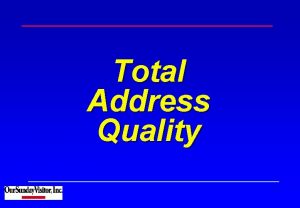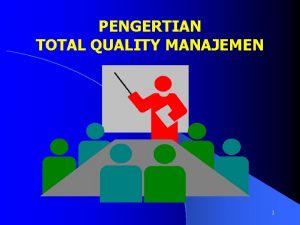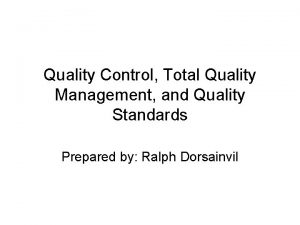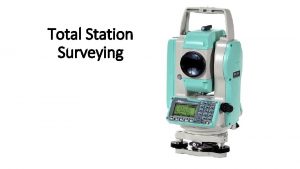Definition Total Quality Management Total Quality Management TQ

























































- Slides: 57

Definition: Total Quality Management • Total Quality Management (TQ, QM or TQM) and Six Sigma (6 ) are sweeping “culture change” efforts to position a company for greater customer satisfaction, profitability and competitiveness. • TQ may be defined as managing the entire organization so that it excels on all dimensions of products and services that are important to the customer. • We often think of features when we think of the quality of a product or service; TQ is about conformance quality, not features.


Total Quality Is… • Meeting Our Customer’s Requirements • Doing Things Right the First Time; Freedom from Failure (Defects) • Consistency (Reduction in Variation) • Continuous Improvement • Quality in Everything We Do

A Quality Management System Is… • A belief in the employee’s ability to solve problems • A belief that people doing the work are best able to improve it • A belief that everyone is responsible for quality

Elements for Success • • • Management Support Mission Statement Proper Planning Customer and Bottom Line Focus Measurement Empowerment Teamwork/Effective Meetings Continuous Process Improvement Dedicated Resources

The Continuous Improvement Process Empowerment/ Shared Leadership Customer Satisfaction Business Results Team Management Process Improvement/ Problem Solving Measurement . . . Measurement

Modern History of Quality Management • Frederick W. Taylor wrote Principles of Scientific Management in 1911. • Walter A. Shewhart used statistics in quality control and inspection, and showed that productivity improves when variation is reduced (1924); wrote Economic Control of Manufactured Product in 1931. • W. Edwards Deming and Joseph M. Juran, students of Shewhart, went to Japan in 1950; began transformation from “shoddy” to “world class” goods. • In 1960, Dr. K. Ishikawa formalized “quality circles” - the use of small groups to eliminate variation and improve processes. • In the late ‘ 70’s and early ‘ 80’s: – Deming returned from Japan to write Out of the Crisis, and began his famous 4 -day seminars in the United States – Phil Crosby wrote Quality is Free – NBC ran “If Japan can do it, why can’t we? ” – Motorola began 6 Sigma

History of Quality Management Deming’s 14 Points 1. Create constancy of purpose for improvement 2. Adopt a new philosophy 3. Cease dependence on mass inspection 4. Do not award business on price alone 5. Work continually on the system of production and service 6. Institute modern methods of training 7. Institute modern methods of supervision of workers 8. Drive out fear 9. Break down barriers between departments 10. Eliminate slogans, exhortations, and targets for the work force 11. Eliminate numerical quotas 12. Remove barriers preventing pride of workmanship 13. Institute a vigorous program of education and retraining 14. Take action to accomplish the transformation

History of Quality Management Deming’s Concept of “Profound Knowledge” Ø Understanding (and appreciation) of Systems - optimizing sub-systems sub-optimizes the total system - the majority of defects come from systems, the responsibility of management (e. g. , machines not in good order, defective material, etc. Ø Knowledge of Statistics (variation, capability, uncertainty in data, etc. ) - to identify where problems are, and point managers and workers toward solutions Ø Knowledge of Psychology (Motivation) - people are afraid of failing and not being recognized, so they fear how data will be used against them Ø Theory of Knowledge - understanding that management in any form is a prediction, and is based on assumptions


History of Total Quality According to Dr. Joseph M. Juran (1991): “On the assembly line at the Ford Motor Company in 1923, most of the workers producing Model T’s were immigrants and could not speak English. Many were also illiterate. Workers learned their trade by modeling the actions of other workers. They were unable to plan, problem-solve, and make decisions. As a result, the Taylor scientific school of management flourished, and MBAs and industrial engineers were invented to do this work. Today, however, the workforce is educated. Workers know what is needed to improve their jobs, and companies that do not tap into this significant source of knowledge will truly be at a competitive disadvantage. ”

History of Total Quality According to Phil Crosby, Quality is. . . An attitude: - Zero Defects - Continuous Improvement A measurement: - Price of Conformance, plus - Price of Nonconformance (defects)

TQ: Transforming an Organization


Quality Function Deployment - QFD At the conclusion of this class – You will have a thorough understanding of: 1. 2. 3. 4. 5. 6. 7. 8. 9. 10. What is QFD? Why it is important? When it is used? How it is used? Understand the function of a QFD Team Realize the Benefits of QFD The Voice of The Customer Organization of information The House of Quality QFD Process

History of QFD c Yoji Akao, a Japanese planning specialist, conceptualized QFD in the 1960’s c. Dr. Shigeru Mizuno, Professor Emeritus of the Tokyo Institute of Technology is credited with initiated the quality function deployment system

History of QFD c Statistical Quality Control, SQC, was the central quality control activity after WWII. • SQC is an effective method of monitoring process using control charts. c SQC became Total Quality Control, TQC. c QFD was derived from TQC.

First Application of QFD • 1966, Bridgestone Tire Corp first used a process assurance table. • 1972, the process assurance table was retooled by Akao to include QFD process. • 1972, Kobe Shipyards (of Mitsubishi Heavy Industry) began a QFD Oil Tanker project. • 1978, Kobe Shipyards published their quality chart for the tanker.



What is Quality Function Deployment? • Quality Function Deployment is a comprehensive quality design method that: • Seeks out spoken and unspoken customer needs from fuzzy Voice of the Customer verbatim; • Uncovers "positive" quality that wows the customer; • Translates these into designs characteristics and deliverable actions; and • Builds and delivers a quality product or service by focusing the various business functions toward achieving a common goal —customer satisfaction.

What is QFD? • Quality Function Deployment, QFD, is a quality technique which evaluates the ideas of key stakeholders to produce a product which better addresses the customers needs. • Customer requirements are gathered into a visual document which is evaluated and remodeled during construction so the important requirements stand out as the end result.

What is QFD? • The link between • • Customer Design Engineer Competitors Manufacturing • Provide Insight • Into the whole design & manufacturing operation • From concept to manufacture (cradle to the grave) • Can improve efficiency

Creative Definitions of QFD § A systematic way of documenting and breaking down customer needs into manageable and actionable detail. § A planning methodology that organizes relevant information to facilitate better decision making. § A way of reducing the uncertainty involved in product and process design. § A technique that promotes cross-functional teamwork. § A methodology that gets the right people together, early, to work efficiently and effectively to meet customers’ needs.

Key Thought Quality Function Deployment is a Valuable Decision Support Tool, But it is Not a Decision Maker Throughout

• WHAT DOES QFD DO? CUSTOMER CONCEPT • Better Designs in Half the Time! “Traditional Timeline” Plan Design Redesign Manufacture Benefits Plan Design Redesign Manufacture QFD is a Productivity Enhancer

The QFD Paradigm • QFD provides the opportunity to make sure you have a good product before you try to design and implement it. • It is about planning and problem prevention, not problem solving. • QFD provides a systematic approach to identify which requirements are a priority for whom, when to implement them, and why.

Why is it important? • QFD is very powerful because it incorporates the voice of customer in the design Resulting in : – A better product design – A satisfied customer – Insight into the design/manufacture operation – Improved problem solving and efficiency in production

When is it used? • Ask these important questions – – – – Why do QFD? What is the goal? What should its make-up be? Is QFD the right tool ? Is this the right time? Is this the right place to implement? What is success? Who all should be involved?

When is QFD Appropriate? § Poor communications and expectations get lost in the complexity of product development. § Lack of structure or logic to the allocation of product development resources. § Lack of efficient and / or effective product / process development teamwork. § Extended development time caused by excessive redesign, problem solving, or putting out fires.

QFD Team 1. Its function in deployment 2. Two Types of Teams New product design Improving an existing design 3. Cross functional • Marketing, design, quality, finance and production

How to use it ? • Comprehensive QFD involves • Four phases:

6 Quality Function Deployment’s House of Quality Correlation Matrix 3 Design Attributes 2 1 Customer Needs Relationships between Customer Needs and Design Attributes 7 § § § Establishes the Flowdown Relates WHAT'S & HOW'S Ranks The Importance 5 4 Importance Rankings The House of Quality Customer Perceptions Costs/Feasibility Engineering Measures 8

The House of Quality v v Key Elements Informational Elements Two Types of Elements in Each House


Levels Of Granularity QFD Flowdown Manufacturing Environment Customer Wants Technical Requirements Part Characteristics Manufacturing Process Software Environment Service Environment Customer Wants Product Functionality Service Requirements System Characteristics Service Processes Design Alternatives Process Controls Production Requirements Flowdown Relates The Houses To Each Other

Building the House of Quality 1. Identify Customer Attributes 2. Identify Design Attributes / Requirements 3. Relate the customer attributes to the design attributes. 4. Conduct an Evaluation of Competing Products. 5. Evaluate Design Attributes and Develop Targets. 6. Determine which Design Attributes to Deploy in the Remainder of the Process.

1. Identify Customer Attributes § These are product or service requirements IN THE CUSTOMER’S TERMS. § Market Research; § Surveys; § Focus Groups. § § § “What does the customer expect from the product? ” “Why does the customer buy the product? ” Salespeople and Technicians can be important sources of information – both in terms of these two questions and in terms of product failure and repair. OFTEN THESE ARE EXPANDED INTO Secondary and Tertiary Needs / Requirements. §

Types of Customer Information and How to Collect it

- “What’s” Key Elements v What Does The Customer Want v Customer Needs v CTQs v Ys s ’ t a h W Voice of the Customer

Customer Requirements Key Elements: v How Important the What’s are TO THE CUSTOMER v Customer Ranking of their Needs er ce m n stoorta u C p Im Voice of the Customer

2. Identify Design Attributes. § Design Attributes are Expressed in the Language of the Designer / Engineer and Represent the TECHNICAL Characteristics (Attributes) that must be Deployed throughout the DESIGN, MANUFACTURING, and SERVICE PROCESSES. § These must be MEASURABLE since the Output will be Controlled and Compared to Objective Targets. § The ROOF of the HOUSE OF QUALITY shows, symbolically, the Interrelationships between Design Attributes.

- “How’s” Key Elements § § How Do You Satisfy the Customer What’s Product Requirements Translation For Action X’s WHAT'S HOW'S How’s s ’ t a h W Satisfing Customer Needs

HOW 7 HOW 6 HOW 5 HOW 4 HOW 3 L L H M 852 1 mm 4 8 atm M 3 M L 40 psi H L M 65 45 H 21 M M L 36 3 mils H L 57 41 48 13 50 6 21 12 in. 5 5 3 4 2 4 1 3 lbs Need 1 Need 2 Need 3 Need 4 Need 5 Need 6 Need 7 HOW 1 Strong Positive Negative Strong Negative HOW 2 v Impact Of The How’s On Each Other Conflict Resolution Information – Correlation Matrix

3. Relating Customer & Design Attributes § Symbolically we determine whethere is NO relationship, a WEAK one, MODERATE one, or STRONG relationship between each Customer Attribute and each Design Attribute. § The PURPOSE it to determine whether the final Design Attributes adequately cover Customer Attributes. § LACK of a strong relationship between A customer attribute and any design attribute shows that the attribute is not adequately addressed or that the final product will have difficulty in meeting the expressed customer need. § Similarly, if a design attribute DOES NOT affect any customer attribute, then it may be redundant or the designers may have missed some important customer attribute.

Need 2 Need 3 Need 4 Need 5 Need 6 Need 7 Untangling The Web 5 5 3 4 2 4 1 H L HOW 7 HOW 6 HOW 5 HOW 4 v Transfer Function v Y = f(X) Need 1 HOW 3 v H Strong 9 v M Medium 3 v L Weak 1 HOW 2 Between the What’s and the How’s HOW 1 Key Elements: Relationship v Strength of the Interrelation L M h Hns io M M L t a l H e R L M s p Mi L H L M

4. Add Market Evaluation & Key Selling Points § This step includes identifying importance ratings for each customer attribute AND evaluating existing products / services for each of the attributes. § Customer importance ratings represent the areas of greatest interest and highest expectations AS EXPRESSED BY THE CUSTOMER. § Competitive evaluation helps to highlight the absolute strengths and weaknesses in competing products. § This step enables designers to seek opportunities for improvement and links QFD to a company’s strategic vision and allows priorities to be set in the design process.

5. Evaluate Design Attributes of Competitive Products & Set Targets. § § This is USUALLY accomplished through in-house testing and then translated into MEASURABLE TERMS. The evaluations are compared with the competitive evaluation of customer attributes to determine inconsistency between customer evaluations and technical evaluations. For example, if a competing product is found to best satisfy a customer attribute, but the evaluation of the related design attribute indicates otherwise, then EITHER the measures used are faulty, OR else the product has an image difference that is affecting customer perceptions. On the basis of customer importance ratings and existing product strengths and weaknesses, TARGETS and DIRECTIONS for each design attribute are set.

M H L L M M L 45 L 21 36 M 8 52 M 8 atm 1 mm 4 3 H HOW 7 HOW 5 HOW 4 HOW 6 M 65 L 40 psi H HOW 3 HOW 2 H L 3 mils 5 5 3 4 2 4 1 57 41 48 13 50 6 21 12 in. Need 1 Need 2 Need 3 Need 4 Need 5 Need 6 Need 7 HOW 1 the How’s v Note the Units 3 lbs Information: How Much v Target Values for Consistent Comparison How Much

Need 2 Need 3 Need 4 Need 5 Need 6 Need 7 5 5 3 4 2 4 1 H L H M H L L HOW 7 HOW 6 HOW 4 More Is Better Less Is Better Specific Amount Need 1 HOW 3 v v v HOW 2 HOW'S HOW 5 v Information On The HOW 1 Information: Target Direction et n g r Ta ctio e Dir M 65 L 45 M M L L H 57 41 48 13 50 The Best Direction 21 36 M 8 52 M 6 4 21

6. Select Design Attributes to be Deployed in the Remainder of the Process § This means identifying the design attributes that: § have a strong relationship to customer needs, § have poor competitive performance, § or are strong selling points. § These attributes will need to be DEPLOYED or TRANSLATED into the language of each function in the design and production process so that proper actions and controls are taken to ensure that the voice of the customer is maintained. § Those attributes not identified as critical do not need such rigorous attention.

Need 1 Need 2 Need 3 Need 4 Need 5 Need 6 Need 7 (CI *Strength) TI = Scolumn CI 5 3 4 2 4 1 45 5 36 12 57 41 HOW 7 HOW 6 HOW 5 HOW 4 HOW 3 HOW 2 Which How’s are Key Where Should The Focus Lie “CI” = “Customer Importance” “Strength” is measured on a 9, 3, 1, 0 Scale HOW 1 Key Elements: Technical Importance v v 5 15 45 9 9 3 2 6 l a 4 36 c i 1 chn n. M ce Te orta p 48 Im 13 50 6 21 Ranking The HOW'S

Need 1 Need 2 Need 3 Need 4 Need 5 Need 6 Need 7 CI *Strength) CC = S (row 5 3 4 2 4 1 HOW 7 HOW 6 HOW 5 HOW 4 HOW 3 HOW 2 Captured v Is A What Really A How HOW 1 Key Elements: Completeness v Are All The How’s M ss. L e Hten le M M L p H ia m o C iter. L M r MC L H L M H L 57 41 48 13 50 Have We Captured the HOW'S 6 21

Using the House of Quality The voice of the customer MUST be carried THROUGHOUT the production process. Three other “houses of quality” are used to do this and, together with the first, these carry the customer’s voice from its initial expression, through design attributes, on to component attributes, to process operations, and eventually to a quality control and improvement plans. In Japan, all four are used. The tendency in the West is to use only the first one or two.

Design Attributes Component Attributes Process Operations 4 Quality Control Plan Process Operations 3 Component Attributes 2 Design Attributes Customer Attributes 1 The How’s at One Level Become the What’s at the Next Level

The voice of the customer • Voice of the customer (VOC) “The efforts to investigate and analyze the customer. With QFD, VOC data is reduce into a set of critical customer needs using techniques such as affinity, diagrams, function analysis, etc, defined and documented in customer needs data dictionary, and prioritized. This VOC effort is also the opportunity to recognize unfulfilled needs that can be provided at minimum, competitive advantage and potentially, a break-through product or true value innovation”

The Cascading Voice of the Customer WHATS NOTES: “Design Attributes” are also called “Functional Requirements” “Component Attributes” are also called “Part Characteristics” “Process Operations” are also called “Manufacturing Processes” and the “Quality Control Plan” refers to “Key Process Variables. Th e Fo ur Y H ou se s Critical to Quality Characteristics (CTQs) of Q ua lit y Key Manufacturing Processes X Key Process Variables
 Contemporary issues in operations management ppt
Contemporary issues in operations management ppt What is tqm
What is tqm Total quality management tools
Total quality management tools Total quality managment
Total quality managment Tqm definition
Tqm definition Total quality management system
Total quality management system Total quality management system
Total quality management system Deming chain reaction
Deming chain reaction Fundamental principles of tqm
Fundamental principles of tqm Praise analysis
Praise analysis What is total quality management in hospitality industry
What is total quality management in hospitality industry Benchmarking in total quality management
Benchmarking in total quality management Quality management gurus
Quality management gurus Ana model of quality assurance
Ana model of quality assurance Total quality management of kfc pdf
Total quality management of kfc pdf Six sigma vs iso 9000
Six sigma vs iso 9000 John talburt
John talburt Toyota and tqm
Toyota and tqm 7 concepts of tqm
7 concepts of tqm How to achieve tqm
How to achieve tqm Introduction of total quality management
Introduction of total quality management Qfd in total quality management
Qfd in total quality management Total quality management wikipedia
Total quality management wikipedia Total quality management in erp
Total quality management in erp Total quality management presentation
Total quality management presentation Pengertian total quality management
Pengertian total quality management David garvin's five approaches to quality
David garvin's five approaches to quality Philosophies of total quality management
Philosophies of total quality management What is tqm? *
What is tqm? * Definisi total quality management
Definisi total quality management Formula de roe
Formula de roe Total revenues minus total costs equals
Total revenues minus total costs equals Total revenues minus total costs equals
Total revenues minus total costs equals Total revenues minus total costs equals
Total revenues minus total costs equals Total revenue minus total expenses
Total revenue minus total expenses Total productive maintenance
Total productive maintenance Total quality control tqc
Total quality control tqc Disadvantages of tqm
Disadvantages of tqm Pengertian tqs
Pengertian tqs Motivating people for total quality
Motivating people for total quality Quality management definition
Quality management definition Project quality management definition
Project quality management definition Types of quality
Types of quality Laboratory quality management system definition
Laboratory quality management system definition Operations and quality management
Operations and quality management Perform quality assurance
Perform quality assurance Pmp quality management
Pmp quality management Quality metrics pmp
Quality metrics pmp Quality improvement vs quality assurance
Quality improvement vs quality assurance Concepts of quality
Concepts of quality Quality is free
Quality is free What is tqm
What is tqm Total war world history definition
Total war world history definition Total peripheral resistance definition
Total peripheral resistance definition What does onto mean in discrete math
What does onto mean in discrete math Total peripheral resistance definition
Total peripheral resistance definition Baroreceptors
Baroreceptors Total fitness definition
Total fitness definition


